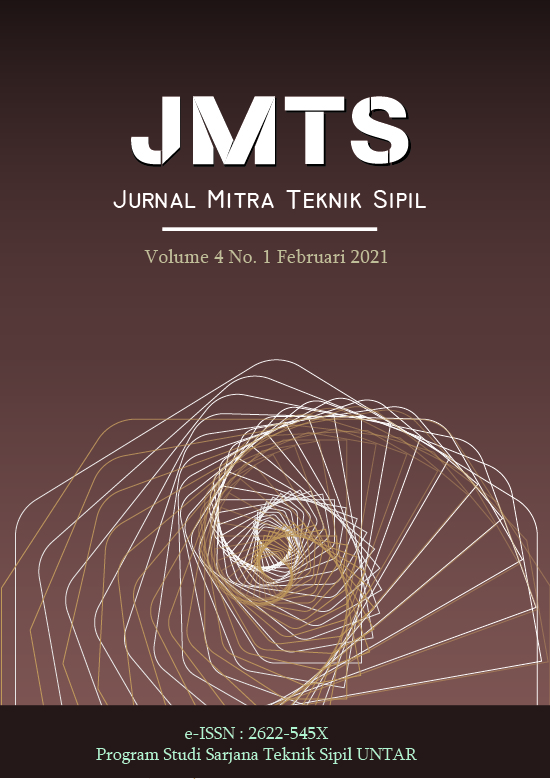DESAIN ULANG DAN ANALISIS RESPONS STRUKTURAL PERKERASAN LENTUR PADA JALAN TOL JAKARTA-CIKAMPEK
Main Article Content
Abstract
This research will redesign the flexible pavement on the Kalihurip-Cikampek toll road using three flexible pavement design methods, namely the 2002, 2013 and 2017 methods, and analyze the structural responses that occur in the form of horizontal and vertical strain, the main components. In calculating the value of repetition of permits against fatigue damage (Nf) and groove cracks (Nd), it is processed using the KENPAVE program. Furthermore, the calculation results of the flexible pavement thickness, the value of repetition of permits against fatigue damage (Nf) and groove crack damage (Nd) were compared from the three methods. The method used is mechanistic-empirical. Primary data is obtained from the Ministry of Public Works and Public Housing and LHR0 starting in 2020, taking into account traffic growth from 2020 to 2035, as well as secondary data assumptions by referring to previous regulations and research. The results of this study indicate that the 2002 method produced the largest pavement thickness, while the 2013 and 2017 methods produced relatively the same pavement thickness. However, the 2002 method produced the largest repetition of permits against fatigue damage (Nf) and groove cracks (Nd). So it can be concluded that the 2017 method produces a better design.
ABSTRAK
Penelitian ini akan mendesain ulang perkerasan lentur pada Jalan Tol Jakarta-Cikampek ruas Kalihurip-Cikampek menggunakan tiga metode desain perkerasan lentur yaitu metode 2002, 2013, dan 2017, serta menganalisis respons struktral yang terjadi berupa regangan horisontal dan vertikal, komponen utama dalam menghitung nilai repetisi izin terhadap kerusakan fatik (Nf) dan retak alur (Nd), diolah menggunakan program KENPAVE. Selanjutnya dibandingkan hasil perhitungan tebal perkerasan lentur, nilai repetisi izin terhadap kerusakan fatik (Nf) dan kerusakan retak alur (Nd) dari ketiga metode tersebut. Metode yang digunakan mekanistik-empiris. Data primer didapat dari Kementerian Pekerjaan Umum dan Perumahan Rakyat (PUPR) dan LHR0 dimulai pada tahun 2020, memperhitungkan pertumbuhan lalu lintas dari tahun 2020 sampai 2035, serta data sekunder asumsi dengan tetap mengacu pada peraturan dan penelitian sebelumnya. Hasil penelitian ini menunjukkan bahwa metode 2002 menghasilkan tebal perkerasan terbesar, sedangkan metode 2013 dan 2017 menghasilkan tebal perkerasan yang relatif sama. Namun metode 2002 menghasilkan repetisi izin terhadap kerusakan fatik (Nf) dan retak alur (Nd) terbesar. Sehingga disimpulkan metode 2017 menghasilkan desain lebih baik.
Article Details
References
A.N. Tajudin dan R. Priyatna. “Effect of Axle and Tire Configurations on Flexible Pavement.” 508.1 (2019): 012004.
Eldon J. Yoder, Matthew W. Witczak. “Principles Of Pavement Design 2nd Edition. New York: John Wiley & Sons, Inc, 1975.
Huang, Yang H. Pavement Analisis and Design. New Jersey: Pearson Education Inc, 2004.
Sukirman, Silvia. Perencanaan Tebal Struktur Perkerasan Lentur. Bandung: Nova, 2010
Putri, C.K. Prediksi Nilai Kerusakan Perkerasan Lentur dengan Metode Mekanistik Empirik (Studi Kasus: Rekonstruksi Jl. Arteri Selatan) (2014): Universitas Gajah Mada.
-, Pedoman Perencanaan Tebal Perkerasan Lentur Pt. T-01-B. Jakarta: Departemen Pemukiman dan Prasarana Wilayah, 2002.
-, Manual Perkerasan Jalan 2013 Nomor 02/M/BM/2013. Jakarta: Kementerian Pekerjaan Umum, 2013.
-, Manual Perkerasan Jalan 2017 Nomor 04/SE/Db/2017. Jakarta: Kementerian Pekerjaan Umum, 2017.


